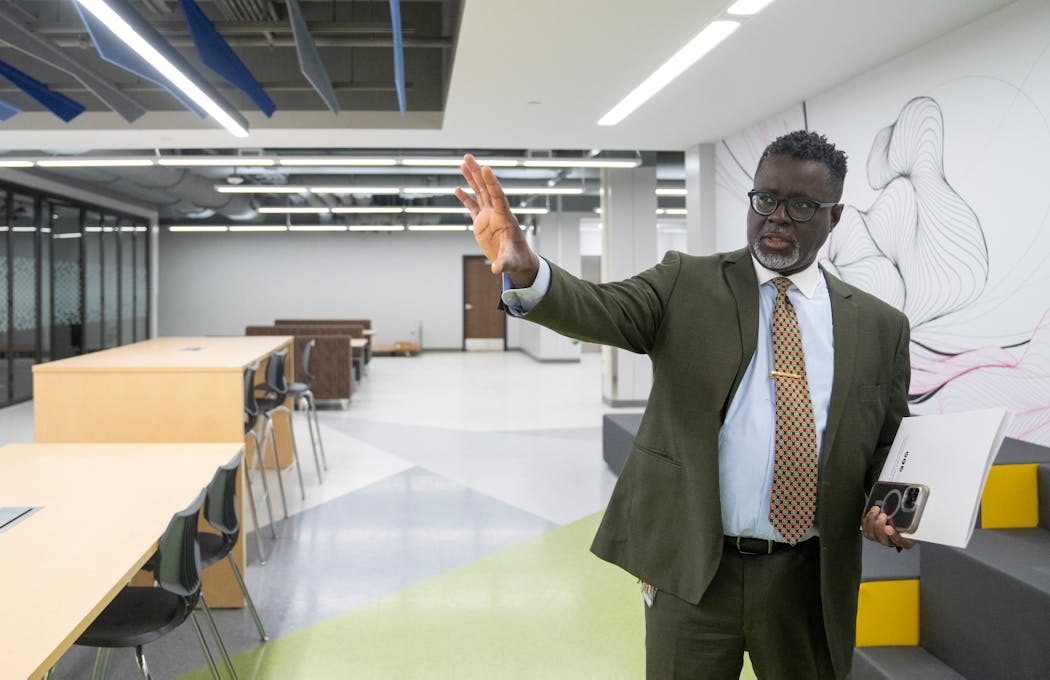Snapping a portrait of classmates in a sprawling photography studio. Designing a three-bedroom home from a classroom computer. Taking a patient's vitals in a replica ambulance parked at the end of a hall.
Those are a few assignments that Minneapolis students have embraced at the new Career and Technical Education Center at North High School, which opened this fall as a hub for engineering, media arts, computer science and emergency medicine programming.
Similar centers are planned for Edison and Roosevelt high schools to centralize programming in construction and welding, business and finance, agriculture, law and public safety, and automotive repair. Juniors and seniors from across the city can take a school bus to the sites — the culmination of a district plan that began in 2019 to elevate such courses and make them more accessible.
Now, they need to persuade students to enroll. Just a couple dozen students attend the center at North High, deterred in part by the travel across the city. But another 200 students take classes online, and leaders are confident the program's popularity will grow.
"You don't put a site like this up just to test the waters," said Michael Luseni, principal of the center at North High, which represented a large portion of an ongoing $88 million renovation of the North Side school. The district has allotted about $3 million for the Edison site and $14 million for Roosevelt. Both are set to be completed in the next few years.
"This is millions of dollars," Luseni said. "The district is making this bet and willing to say, 'This can work.'"
Minneapolis isn't the only district leaning into these types of programs, which now extend far beyond the trades-based "shop" courses that once defined vocational education. Leaders with Robbinsdale public schools are beginning conversations about creating a "career pathways" center in the district, and schools in the Chicago area have contacted Luseni to talk about the model at North. Many of the programs allow students to earn college credit and industry certifications to jumpstart their post-high school job options.
"We are definitely seeing continued growth and interest in career and technical education programs around the country," said Alisha Hyslop, the chief policy, research and content officer for the national Association for Career and Technical Education.
How and what such programming looks like, however, differs from community to community, depending on the needs of the local economy, Hyslop said.
"CTE programs are doing everything we can to keep up with the changing labor market and the new jobs that are coming," she said.
For example, a math classroom may not look much different than it did 40 years ago. But career and technical courses "should be constantly changing," Hyslop said.
Providing opportunity
When people think of technical or vocational programs, they often envision trades-based classes designed for students who aren't planning to attend a four-year college, said Frank Herman, the director of college and career pathways — a new position for Robbinsdale schools. Over the decades, those types of classes have trended in and out of high schools.
"The pendulum doesn't have to swing so far" between a focus on college prep or workforce readiness, he said. "They don't have to be exclusive of each other — they need to be braided together."
Luseni agrees.
He wants students who graduate from the North High program to have enough skills — and sometimes certifications — to land a well-paying entry-level position in a field that interests them. They can use that income to attend college part-time and earn a degree. Or they can go straight into college already confident in what they want to study because of their experience in the field, he said.
"Before, the only game in town was, 'Here's my diploma,'" Luseni said. "But these programs aren't just like an elective class. They provide the training that creates opportunity."
The center at North High has partnerships with more than 70 companies, colleges and universities and organizations, including Cargill, General Mills, Target and Fairview — potential employers who want to bolster the talent pipeline.
"When we talk to our partners, we say we don't want you to come and do the typical presentation," Luseni said. "We're interested in helping our young people to see you and see your company as an option for the future."
A partnership with a local car dealership, for example, could give students a chance to learn about not just mechanics but also business management and even promotional photography, Luseni said.
'Empty building'
While the Minneapolis career education centers may have buy-in from area partners, the vision of the centers has so far been slow to gain popularity among the city's teens.
Just 28 students attend in-person classes at the North Career and Technical Education Center. The booths and chairs in the North High center's halls — meant for group projects — remain empty throughout the day, as do many of the open-concept classroom spaces.
Many of the programs now at North were pulled from other high schools. Students who wanted to continue those courses were expected to ride city buses to and from North High, and that proved unpopular.
Months into the school year, the district began providing school buses for those students — but the decision came too late to help fill the North center's classrooms for the first semester. About 200 students opted to take the site's courses online instead.
"It's a really nice space," said Myles Wooster, a senior at Southwest who takes engineering courses at North and plans to pursue a career in engineering. "But it's still a pretty empty building."
Before this year, the career and technical courses were open to all high schoolers. But the model is now aimed at just upperclassmen — a move that has also cut into enrollment. This fall, nearly 30% of juniors and seniors took career and technical classes.
Luseni hopes the drone lab, photo studio and group work spaces will all be bustling with students next year.
"We have to allow people to come here and see it — that's how we sell it," he said. "I know this was an unknown for a lot of people. But this is the bet the district made. And if we're going big, we can't stop now."

Wolves vs. Nuggets series updates: Times for first four games set
Medical examiner identifies pedestrian hit by vehicle and killed in Bloomington
Souhan: A sausage? A knee surgery? Minnesota sports has gone mad




